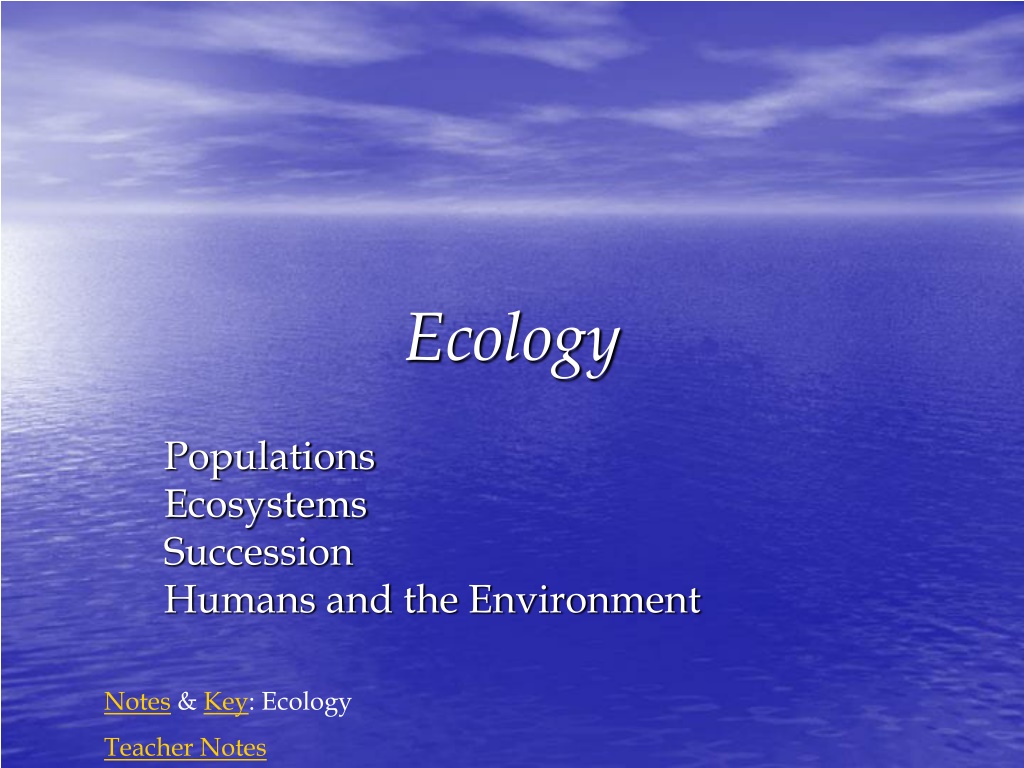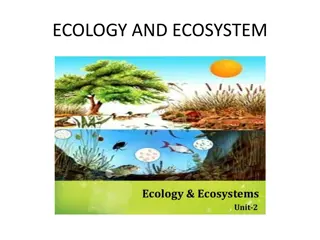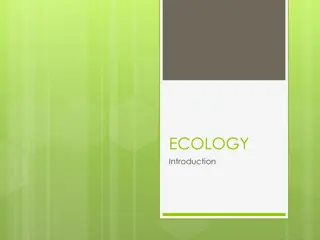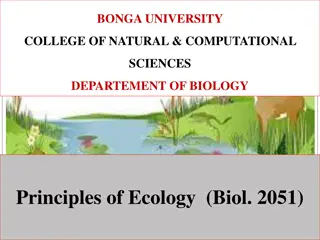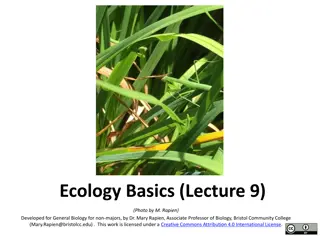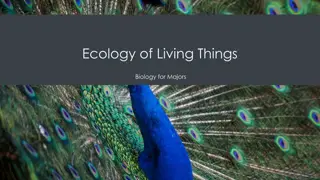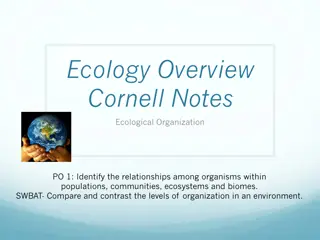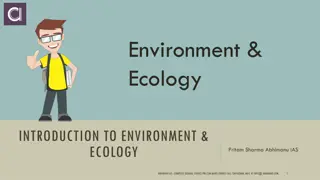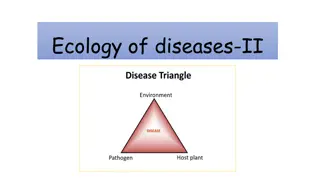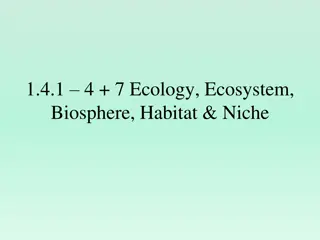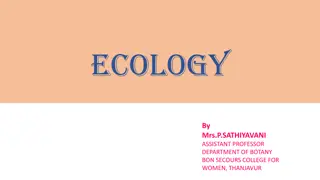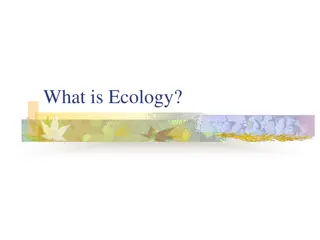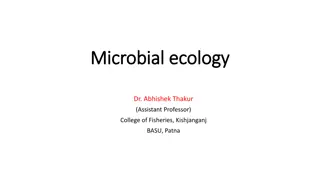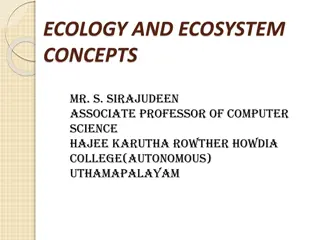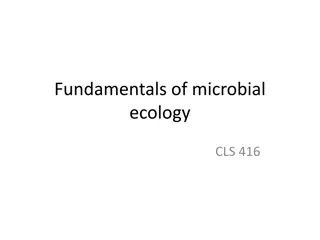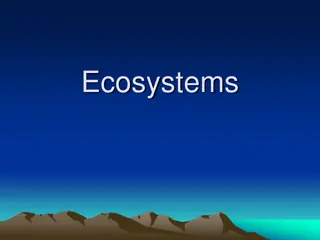Understanding Ecology: Populations, Ecosystems, and Relationships
Explore key concepts in ecology including populations, population size and density, dispersion patterns, population growth, habitat and niche relationships, symbiosis, ecosystem energy flow, and roles of producers, consumers, and decomposers.
Download Presentation

Please find below an Image/Link to download the presentation.
The content on the website is provided AS IS for your information and personal use only. It may not be sold, licensed, or shared on other websites without obtaining consent from the author. Download presentation by click this link. If you encounter any issues during the download, it is possible that the publisher has removed the file from their server.
E N D
Presentation Transcript
Ecology Populations Ecosystems Succession Humans and the Environment Notes & Key: Ecology Teacher Notes
Population Population size Refers to the number of individuals in a population Factors that influence this size Abiotic nonliving, such as temperature, moisture, air, salinity, and pH Biotic all the living organisms that inhabit the environment
Population density Refers to the number of individuals found within a given area If too wide spread, they rarely encounter each other difficult to reproduce
Dispersion Refers to the way in which the individuals of the population are arranged Even individuals are located at equal intervals Clumped bunched together in clusters Random location of each individual is determined by chance
Population Growth population grows when more individuals are born than die Carrying capacity when a population has reached the maximum size that the environment can support Size is determined by limiting factors Food, water, shelter
Populations living areas Habitat = the area in which an organism lives Niche = the role the organism has in an ecosystem
Population relationships Symbiosis close association between two different types of organisms a scientific living together Mutualism both organisms benefit (lichen) Commensalism one organism benefits and the other is neither harmed nor helped (epiphytes) Parasitism one organism benefits and the other is harmed (flea)
Ecosystems Energy Flow Producers - make their own food (green plants, algae, some bacteria) Consumers - obtain their food from others Herbivores primary consumers that eat plants Carnivores secondary consumers that eat flesh Omnivores secondary or tertiary consumers that eat plants and flesh Decomposers eat dead and decaying organisms
Food Chain Trophic levels Clover Rabbit Snake Hawk
Food Web Food chains that interconnect and overlap
Pyramid of biomass Total mass of organisms at each trophic level Pyramid of numbers Number of organisms at each trophic level Pyramid of energy Amount of energy at each trophic level Each trophic level receives ~ 10% from the next higher level
Cycles Water cycle Nonliving Condensation, precipitation, evaporation Living Absorption, transpiration
Carbon cycle Atmospheric carbon Photosynthesis Cellular respiration
Nitrogen cycle Atmospheric nitrogen Nitrogen-fixing bacteria Nitrates Nitrites Plants Animals Decomposers
Oxygen cycle Oxygen in air and water Cellular respiration Water Photosynthesis
Succession Populations in an area are replaced by other populations Organisms make the environment less conducive for their existence and more conducive for the next level
Primary succession where life did not exist before Pioneer species Continuing species change Climax community Ex. lichen, grasses, small bushes, small trees, mature softwoods (pines, balsams, firs), mature hardwoods (oaks, hickories)
Secondary succession where a prior community was destroyed (by fire, flood, volcanic eruption, abandoned farming, mining, logging, etc.) Pioneer species Continuing species change Climax community
Humans and the Environment Conservation Wise management of the Earth s natural resources Renewable resources Nonrenewable resources
Renewable resources Wildlife Many threatened or endangered Extinction occurs when a species disappears from Earth Habitat destruction is major cause
Forests Becoming smaller due to increased demand for wood and wood products Deforestation occurs where large areas of forest are cut and cleared. Ex. tropical rainforests Cut and burned to clear land for farming Topsoil is thin, good for one, or maybe two, years Then more must be cleared When land is cleared, rain ceases as trees caused the rain through transpiration Land becomes a desert Reforestation is a solution
Soil good soil is needed to grow plants for food and for fibers to make cloth Erosion can be prevented Windbreaks Contour plowing Terrace plowing Strip cropping Crop rotation
Nonrewable resources Water Most important Cannot live without it Watersheds Desalination
Fossil Fuels Coal, natural gas, oil Alternative energy forms solar energy nuclear energy wind power geothermal energy water energy
Pollution Air pollution Most comes from burning fossil fuels Smog smoke and fog Acid rain oxides from burning fossil fuel combine with moisture in air Temperature inversion Layer of warm air becomes trapped between layers of cool air Air pollutants become trapped in cool air Do not rise form the earth, stay near ground
Water pollution Agricultural runoff Industrial waste products One major example is hot water Causes thermal pollution Hot water holds less oxygen than cold water
